Marketing Strategy Metamorphosis Under the Impact of Artificial Intelligence Services
Abstract
1. Introduction
1.1. AI and Marketing Strategies and Brands
1.2. AI and Marketing Decision-Making
1.3. AI and Sentiment Analysis
1.4. Paper Contributions and Structure
2. Materials and Methods
3. Results
3.1. Types of Customers’ Online Feedback
- Positive sentiment. This expresses satisfaction, enthusiasm, or endorsement of a product or service (e.g., “excellent quality”, “very useful”, “highly recommend”, etc.);
- Negative sentiment. It reflects dissatisfaction, criticism, or frustration (e.g., “poor design”, “does not work as expected”, “disappointed”, etc.);
- Neutral or mixed sentiment. It contains positive and negative elements or lacks strong sentiment indicators. These statements were excluded from the dataset to ensure clarity in analysis.
- True positive (TP) signifies the number of texts expected to be positive by the researcher and correctly classified as positive by Azure Text Analytics. In other words, let us assume that a text was initially labeled as positive, and the Azure Text Analytics returned the same classification. This case is considered a TP. Therefore, the value of TP is incremented by one unit;
- True negative (TN) is the number of text expected to be negative by the researcher and correctly recognized as negative by Azure Text Analytics. Maintaining the logic of the previous example, if specific feedback was initially known to be labeled as negative and the Azure Text Analytics returned the same classification, this case is considered a TN. Consequently, TN is incremented by one unit in this case;
- False positive (FP) represents the number of texts expected to be negative by the researcher but incorrectly classified as positive by Azure Text Analytics. This type of error indicates an overestimation of the positive sentiment;
- False negative (FN) is the number of texts expected to be positive by the researcher but incorrectly recognized as negative by Azure Text Analytics. This type of error shows an inflate of the negative sentiment.
- Accuracy assesses the true forecasts from all the model’s predictions and is computed using Equation (1).
- Precision shows the true predictions out of all positive forecasts and is calculated with Equation (2).
- Recall measures the true estimates out of all predictions expected as true and is calculated with Equation (3).
- F1-Score establishes the model’s effectiveness based on Precision and Recall and is computed with Equation (4).
3.2. Feedback Domains, Subdomains, and Keywords
- Product (Frequency: 2551). The high frequency of product mentions indicates a significant focus on product-related discussions within the analyzed texts. This suggests that customers actively provide feedback or evaluations on various products offered within the hospitality industry, highlighting the importance of product quality and features in their experiences.
- Location (Frequency: 1476). The prominence of location mentions strongly emphasizes geographic references within the analyzed texts. This could include discussions about specific hotel properties, destinations, or geographical features relevant to the hospitality industry, providing context for customer experiences and preferences.
- Skill (Frequency: 1084). The frequency of skill mentions suggests a notable focus on discussions related to skills, abilities, or expertise within the analyzed texts. This could pertain to the skills of hotel staff, service providers, or other professionals within the hospitality industry, indicating the importance of service quality and expertise in customer experiences.
- DateTime (Frequency: 484). The presence of DateTime mentions indicates a consideration of temporal aspects within the analyzed texts. This could include discussions about specific dates, times, or time intervals relevant to events, promotions, or experiences within the hospitality industry, providing temporal context for customer feedback and evaluations.
- Event (Frequency: 441). The frequency of event mentions suggests discussions about specific events, occurrences, or happenings within the analyzed texts. This could include events hosted by hotels, special promotions, or noteworthy incidents relevant to customer experiences in the hospitality industry, highlighting the significance of events in shaping customer perceptions and feedback.
- PersonType (Frequency: 324). PersonType mentions indicate discussions about different types of individuals or roles within the analyzed texts. This could include mentions of customers, staff members, management personnel, or other stakeholders within the hospitality industry, providing insights into the diverse range of stakeholders involved in customer experiences.
- Organization (Frequency: 220). The frequency of organization mentions suggests discussions about various organizational entities within the analyzed texts. This could include mentions of hotel chains, hospitality brands, or other organizational structures relevant to the hospitality industry, providing insights into the organizational context of customer experiences and feedback.
- Quantity (Frequency: 40). While less frequent than other domains, quantity mentions indicate discussions about numerical quantities or amounts within the analyzed texts. This could include discussions about quantities of products, services, or amenities hotels offer, highlighting quantitative aspects of customer experiences and feedback.
- Structural (Frequency: 451). It may encompass topics such as design, layout, or organization, providing insights into the structural aspects relevant to customer experiences or product evaluations.
- Set (Frequency: 117). The frequency of mentions related to set suggests discussions about collections, groups, or predefined sets within the analyzed texts. This could include mentions of bundled products, package deals, or predefined service offerings, highlighting the significance of set-based offerings in the context of marketing strategies.
- Duration (Frequency: 115). Duration likely refers to mentions of time durations, periods, or intervals within the analyzed texts. This subdomain may encompass discussions about the duration of events, promotions, or customer experiences, providing insights into the temporal aspects of marketing campaigns and initiatives.
- Sports (Frequency: 64). Sports suggests discussions about sports-related activities, events, or amenities within the analyzed texts. This could include mentions of sports facilities, recreational activities, or fitness programs offered by hospitality establishments, indicating a focus on sports-related offerings in customer experiences.
- State (Frequency: 39). State likely pertains to mentions of states, conditions, or statuses within the analyzed texts. This subdomain may encompass discussions about facilities, equipment, or services, providing insights into the current condition or status of offerings relevant to customer experiences.
- TimeRange (Frequency: 39). TimeRange likely refers to mentions of time ranges, periods, or intervals within the analyzed texts. This subdomain may overlap with discussions related to duration but focuses specifically on the range or period associated with events, promotions, or experiences.
- Computing (Frequency: 32). Computing suggests discussions about computing technologies, systems, or applications within the analyzed texts. This could include mentions of digital technologies, IT infrastructure, or online platforms used in hospitality or product-related contexts.
- Number (Frequency: 26). Number likely refers to numerical values or quantities mentioned within the analyzed texts. This subdomain may encompass discussions about numerical data, metrics, or statistics relevant to customer experiences, product evaluations, or marketing performance.
3.3. AMSDM
- Collecting the feedback from the customer;
- Identifying the sentiment expressed in feedback (positive or negative);
- Identifying the keywords in the feedback;
- Identifying and prioritizing domains and subdomains relevant to product or service reviews. If the sentiment is negative, then action should be taken. Identifying the main domain in the feedback to decide if there is a product or service feedback:
- For product feedback, global customer satisfaction is calculated using Equation (5);sentiment is 1 for positive sentiment and 0 for negative sentiment;i—current review for the product or service;n—total number of reviews for the same product or service;
- ■
- If global customer satisfaction is lower than 60%, the authors propose improving the product experience. The negative feedback can be used to identify areas for improvement in products or services offered and launch marketing campaigns focused on promoting enhancements and solutions to the reported issues;
- ■
- Otherwise, the monitoring process will continue.
- For service feedback, the review type will be identified using the subdomain:
- ■
- If staff service reviews, improve the company’s staff services;
- ■
- Otherwise, improve the tangibility.
- If the sentiment is positive, the identified keywords are used to create personalized ads that capture customers’ attention and offer relevant solutions;
- Monitoring the performance of implemented marketing campaigns and customer reactions.
- Comprehensive Analysis. By gathering and assessing feedback from various origins, the AMSDM thoroughly comprehends customer sentiments, inclinations, and requirements spanning multiple domains, such as food and non-food products, restaurants, the hospitality sector, transportation, etc.
- Customization. The AMSDM can be easily customized to accommodate the specific requirements of different industries or domains. Minimal adjustments are required to tailor the AMSDM to meet the unique needs of each analyzed domain.
- Data-Driven Insights. The AMSDM extracts textual data by integrating Azure Text Analytics and sentiment analysis techniques, enabling marketers to make informed decisions based on data-driven analysis rather than subjective interpretations.
- Enhanced Decision Making. By identifying domains, subdomains, and keywords relevant to customer feedback, the AMSDM facilitates targeted decision making in marketing campaigns. Marketers can focus on areas of concern, capitalize on emerging trends, and tailor strategies to better resonate with their target audience.
- Actionable Recommendations. The AMSDM provides actionable recommendations based on sentiment analysis results and domain-specific insights. Whether addressing negative feedback to improve product experiences or leveraging positive sentiments to craft personalized marketing messages, the AMSDM offers concrete strategies for enhancing customer satisfaction.
- Continuous Optimization. The AMSDM supports constantly optimizing marketing strategies by monitoring the performance of implemented marketing campaigns and analyzing subsequent feedback. Marketers can adapt their approaches in real time based on evolving customer preferences and market dynamics, ensuring ongoing relevance and effectiveness.
4. Discussion
- Sentiment Analysis. Marketers can gauge overall sentiment towards their products or services by analyzing customer feedback and reviews. Positive sentiment can be leveraged for marketing campaigns to highlight strengths and build brand reputation. Conversely, addressing negative sentiment allows for targeted improvements and customer retention strategies.
- Identifying Trends and Themes. Text Analytics can identify recurring topics, themes, and trends in customer feedback or social media discussions. Marketers can use this information to tailor marketing campaigns, develop relevant content, and capitalize on market opportunities.
- Customer Insights. Analyzing customer feedback depicts the preferences, challenges, and expectations, empowering marketers to develop a profound understanding of their target audience. This understanding facilitates the customization of marketing messages and the adaptation of offerings to address customer needs effectively.
- Competitive Analysis. Text Analytics allows for monitoring competitor activities, sentiment, and customer feedback. This enables marketers to identify strengths and weaknesses compared to competitors, assess performance against benchmarks, and develop strategies to distinguish their offerings in the market.
- Campaign Evaluation. Text Analytics can assess the impact of marketing campaigns by examining customer responses and sentiment toward particular initiatives. This enables marketers to evaluate their campaigns’ efficacy, identify areas for improvement, and adapt future strategies accordingly.
- Content Optimization. Analyzing customer language and preferences allows marketers to optimize content creation and delivery. By comprehending which messaging connects most effectively with their audience, marketers can craft compelling content that boosts engagement and conversion.
5. Conclusions
Author Contributions
Funding
Data Availability Statement
Acknowledgments
Conflicts of Interest
Abbreviations
| AI | Artificial intelligence |
| AMSDM | Algorithm for Marketing Strategy Decision Making |
| CNN | Convolutional neural network |
| DL | Deep learning |
| FN | False negative |
| FP | False positive |
| IoT | Internet of Things |
| LP | Long phrases |
| LSTM | Long short-term memory |
| ML | Machine learning |
| MSDM | Marketing strategy decision making |
| NLP | Natural language processing |
| SF | Short phrases |
| TN | True negative |
| TP | True positive |
References
- Stancu, A. Population Number and Consumer Income and Expenditure Dynamics. In Megacities and Rapid Urbanization: Breakthroughs in Research and Practice; Information Resources Management Association, Ed.; IGI Global: Hershey, PA, USA, 2020; pp. 31–75. [Google Scholar] [CrossRef]
- Rosca, C.-M.; Gortoescu, I.A.; Tanase, M.R. Artificial Intelligence–Powered Video Content Generation Tools. Rom. J. Pet. Gas Technol. 2024, 5, 131–144. [Google Scholar] [CrossRef]
- Pașcalău, S.-V.; Popescu, F.-A.; Bîrlădeanu, G.-L.; Gigauri, I. The Effects of a Digital Marketing Orientation on Business Performance. Sustainability 2024, 16, 6685. [Google Scholar] [CrossRef]
- Gigauri, I. Sustainability and Healthcare Marketing in the Digital Age. In Modern Healthcare Marketing in the Digital Era; Djakeli, K., Ed.; IGI Global: Hershey, PA, USA, 2023; pp. 104–115. [Google Scholar] [CrossRef]
- Lulaj, E.; Tahiraj, D.; Hameed, A.A.; Lulaj, D. Seeing Isn’t Always Believing: Unveiling the Financial Risks of Fraudulent Images on Personal Finances in Online Shopping. In Proceedings of the 2nd International Conference on Artificial Intelligence, Blockchain, Mount Pleasant, MI, USA, 7–8 September 2024; pp. 1–10. [Google Scholar] [CrossRef]
- Brătucu, G.; Ciobanu, E.; Chițu, I.B.; Litră, A.V.; Zamfirache, A.; Bălășescu, M. The Use of Technology Assisted by Artificial Intelligence Depending on the Companies’ Digital Maturity Level. Electronics 2024, 13, 1687. [Google Scholar] [CrossRef]
- Ziakis, C.; Vlachopoulou, M. Artificial Intelligence in Digital Marketing: Insights from a Comprehensive Review. Information 2023, 14, 664. [Google Scholar] [CrossRef]
- Stancu, A. An analysis of the relation between wine consumption and cultural models. Ekon. Poljopr. 2015, 62, 207–227. [Google Scholar] [CrossRef]
- Shahzad, U.; Ghaemi Asl, M.; Panait, M.; Sarker, T.; Apostu, S.A. Emerging interaction of artificial intelligence with basic materials and oil & gas companies: A comparative look at the Islamic vs. conventional markets. Resour. Policy 2023, 80, 103197. [Google Scholar] [CrossRef]
- Balaram, A.; Kannan, K.N.; Čepová, L.; Kumar, M.K.; Rani, B.S.; Schindlerova, V. Artificial Intelligence for Media Ecological Integration and Knowledge Management. Systems 2023, 11, 222. [Google Scholar] [CrossRef]
- Aldhyani, T.H.H.; Alzahrani, A. Framework for Predicting and Modeling Stock Market Prices Based on Deep Learning Algorithms. Electronics 2022, 11, 3149. [Google Scholar] [CrossRef]
- Zhang, Y.; Liu, C. Unlocking the Potential of Artificial Intelligence in Fashion Design and E-Commerce Applications: The Case of Midjourney. J. Theor. Appl. Electron. Commer. Res. 2024, 19, 654–670. [Google Scholar] [CrossRef]
- Chandra, K.V.; Sudha Rani, K.; Singh, P.; Rambabu, C.V.; Vidya Sagar, K.; Billa, P. Artificial Intelligence Techniques to Revolutionize the Marketing Strategies for Enormous Business Expansion. In Proceedings of the First International Conference on Advances in Electrical, Electronics and Computational Intelligence, Tiruchengode, India, 19–20 October 2023; pp. 1–5. [Google Scholar] [CrossRef]
- Lulaj, E.; Dragusha, B.; Lulaj, D. Market Mavericks in Emerging Economies: Redefining Sales Velocity and Profit Surge in Today’s Dynamic Business Environment. J. Risk Financ. Manag. 2024, 17, 395. [Google Scholar] [CrossRef]
- Lakshmi Priyanka, A.; Harihararao, M.; Prasanna, M.; Deepika, Y.A. A Study on Artificial Intelligence in Marketing. Int. J. Multidiscip. Res. 2023, 5, 1–12. [Google Scholar] [CrossRef]
- Rosca, C.-M. Convergence Catalysts: Exploring the Fusion of Embedded Systems, IoT, and Artificial Intelligence. In Engineering Applications of AI and Swarm Intelligence; Yang, X.-S., Ed.; Springer Nature: Singapore, 2025; pp. 69–87. [Google Scholar] [CrossRef]
- Alexa, L.; Pîslaru, M.; Nistor, G.C.; Alexa, M. Artificial Intelligence in Marketing. Current Status and Future Research Agenda. In Digital Transformation. Technology, Tools, and Studies; Cioca, L.I., Ivascu, L., Filip, F.G., Doina, B., Eds.; Springer Nature: Cham, Switzerland, 2024; pp. 39–51. [Google Scholar] [CrossRef]
- Mshvidobadze, T.I.; Osadze, L.T.; Sosanidze, M.O. Adapting digital marketing to artificial intelligence. Econ. Bull. Dnipro Univ. Technol. 2023, 122–125. [Google Scholar] [CrossRef]
- Panait, M.; Raimi, L. Trends in Sustainable Behaviour of Consumers in Eastern Europe and Sub-Saharan Africa: A Critical Discourse. In Sustainable Production and Consumption Systems; Chiappetta Jabbour, C.J., Khan, S.A.R., Eds.; Springer: Singapore, 2021; pp. 41–58. [Google Scholar] [CrossRef]
- Efendioğlu, İ.H. The Change of Digital Marketing with Artificial Intelligence. In Proceedings of the 7th International Conference on Applied Research in Management, Economics and Accounting, Dublin, Ireland, 28–30 July 2023; pp. 1–31. [Google Scholar] [CrossRef]
- Marić, M.; Grljević, O.; Gluščević, L. Application of artificial intelligence in digital marketing. Anal. Ekon. Fak. U Subotici 2024, 60, 21–37. [Google Scholar] [CrossRef]
- Liu, Y. Enterprise Brand Marketing Strategy under the Background of Artificial Intelligence. In Proceedings of the International Conference on Forthcoming Networks and Sustainability in AIoT Era, Nicosia, Turkey, 27–28 December 2021. [Google Scholar] [CrossRef]
- Kagada, J. Artificial Intelligence in Marketing. Int. Res. J. Adv. Eng. Manag. 2024, 2, 151–155. [Google Scholar] [CrossRef]
- Labib, E. Artificial intelligence in marketing: Exploring current and future trends. Cogent Bus. Manag. 2024, 11, 2348728. [Google Scholar] [CrossRef]
- Yang, J.; Wan, Y. The development trend of artificial intelligence in the big data environment. In Proceedings of the 3rd International Conference on Electronic Communication and Artificial Intelligence, Zhuhai, China, 14–16 January 2022; pp. 301–304. [Google Scholar] [CrossRef]
- Gigauri, I.; Palazzo, M.; Apostu, S.A.; Siano, A. Revealing intelligent packaging for food products from consumers’ point of view in Georgia. Br. Food J. 2024, 126, 3718–3739. [Google Scholar] [CrossRef]
- Justino, M.d.R.T.F.; Texeira-Quirós, J.; Gonçalves, A.J.; Antunes, M.G.; Mucharreira, P.R. The Role of Artificial Neural Networks (ANNs) in Supporting Strategic Management Decisions. J. Risk Financ. Manag. 2024, 17, 164. [Google Scholar] [CrossRef]
- Kim, K.; Kim, B. Decision-Making Model for Reinforcing Digital Transformation Strategies Based on Artificial Intelligence Technology. Information 2022, 13, 253. [Google Scholar] [CrossRef]
- Rosca, C.-M. New Algorithm to Prevent Online Test Fraud Based on Cognitive Services and Input Devices Events. In Proceedings of Third Emerging Trends and Technologies on Intelligent Systems, ETTIS 2023; Lecture Notes in Networks and Systems; Noor, A., Saroha, K., Pricop, E., Sen, A., Trivedi, G., Eds.; Springer Nature: Singapore, 2023; Volume 730, pp. 207–219. [Google Scholar] [CrossRef]
- Stancu, A.; Ene, C. Highlights of food waste consumer behaviour in households and food services sector. In Contemporary Marketing and Consumer Behaviour in Sustainable Tourism; Palazzo, M., Foroudi, P., Eds.; Routledge: Abingdon, UK, 2024; pp. 63–98. [Google Scholar] [CrossRef]
- Zhou, C.; Li, H.; Zhang, L.; Ren, Y. Optimal Recommendation Strategies for AI-Powered E-Commerce Platforms: A Study of Duopoly Manufacturers and Market Competition. J. Theor. Appl. Electron. Commer. Res. 2023, 18, 1086–1106. [Google Scholar] [CrossRef]
- Gigauri, I.; Palazzo, M.; Siano, A. Examining the Market Potential for Smart Intelligent Packaging: A Focus on Italian Consumers. Virtual Econ. 2024, 7, 89–116. [Google Scholar] [CrossRef]
- Jhaveri, M.; Chirputkar, A.; Ashok, P. The Efficacy of Artificial Intelligence in making Best Marketing Decisions. In Proceedings of the International Conference on Innovative Data Communication Technologies and Application, Uttarakhand, India, , 14–16 March 2023; pp. 225–229. [Google Scholar] [CrossRef]
- Sun, R. Analysis on the application of artificial intelligence in marketing. In Proceedings of the International Conference on Computer Information Science and Artificial Intelligence, Kunming, China, 17–19 September 2021; pp. 669–672. [Google Scholar] [CrossRef]
- Lulaj, E.; Dragusha, B.; Hysa, E.; Voica, M.C. Synergizing Sustainability and Financial Prosperity: Unraveling the Structure of Business Profit Growth through Consumer-Centric Strategies—The Cases of Kosovo and Albania. Int. J. Financ. Stud. 2024, 12, 35. [Google Scholar] [CrossRef]
- Todorova, A.; Antonova, D. Smart Marketing Solutions: Applications with Artificial Intelligence to Increase the Effectiveness of Marketing Operations. In Proceedings of the 7th International Symposium on Multidisciplinary Studies and Innovative Technologies, Ankara, Turkiye, 26–28 October 2023; pp. 1–6. [Google Scholar] [CrossRef]
- Liu, Y.; Li, Z. Application Analysis of Artificial Intelligence Technology in Brand Marketing Strategy. In Proceedings of the International Conference on Forthcoming Networks and Sustainability in AIoT Era, Nicosia, Turkey, 27–28 December 2021; pp. 120–124. [Google Scholar] [CrossRef]
- Rosca, C.-M. Vector Network Analyzer Monitoring System Using Raspberry PI. Pet.-Gas Univ. Ploiesti Bull. Tech. Ser. 2018, 70, 29–38. Available online: https://openurl.ebsco.com/EPDB%3Agcd%3A5%3A13200965/detailv2?sid=ebsco%3Aplink%3Ascholar&id=ebsco%3Agcd%3A136232604&crl=c (accessed on 20 January 2025).
- Khodeer, S.M.; Al-Shaikh, M.S. The Impact of Marketing Artificial Intelligence (MAI) Tools On the Customer Buying Decision-Jordan. In Proceedings of the 24th International Arab Conference on Information Technology, Ajman, United Arab Emirates, 6–8 December 2023; pp. 1–8. [Google Scholar] [CrossRef]
- Singh, N.; Chouhan, S.S. Role of Artificial Intelligence for Development of Intelligent Business Systems. In Proceedings of the IEEE International Symposium on Smart Electronic Systems, Jaipur, India, 18–22 December 2021; pp. 373–377. [Google Scholar] [CrossRef]
- Hari Krishna, S.; Sargunam, S.S.; Kulkarni, N.; Nandal, N.; Vidya Chellam, V.; Praveenkumar, S. Application of Artificial Intelligence in E-Marketing. In Proceedings of the International Conference on Artificial Intelligence and Knowledge Discovery in Concurrent Engineering, Chennai, India, 5–7 January 2023; pp. 1–7. [Google Scholar] [CrossRef]
- Gu, Y.; Shibukawa, T.; Kondo, Y.; Nagao, S.; Kamijo, S. Prediction of Stock Performance Using Deep Neural Networks. Appl. Sci. 2020, 10, 8142. [Google Scholar] [CrossRef]
- Albaooth, B. The Role of Artificial Intelligence Prediction in Stock Market Investors Decisions. In Proceedings of the IEEE Asia-Pacific Conference on Computer Science and Data Engineering, Nadi, Fiji, 4–6 December 2023; pp. 1–5. [Google Scholar] [CrossRef]
- Abbas, W.; Zhang, Z.; Asim, M.; Chen, J.; Ahmad, S. AI-Driven Precision Clothing Classification: Revolutionizing Online Fashion Retailing with Hybrid Two-Objective Learning. Information 2024, 15, 196. [Google Scholar] [CrossRef]
- Rodríguez-Díaz, M.; Rodríguez-Díaz, R.; Rodríguez-Voltes, A.C.; Rodríguez-Voltes, C.I. Analysing the Relationship between Price and Online Reputation by Lodging Category. Sustainability 2018, 10, 4474. [Google Scholar] [CrossRef]
- Qaffas, A.A.; Ben Hajkacem, M.-A.; Ben Ncir, C.-E.; Nasraoui, O. An Explainable Artificial Intelligence Approach for Multi-Criteria ABC Item Classification. J. Theor. Appl. Electron. Commer. Res. 2023, 18, 848–866. [Google Scholar] [CrossRef]
- Rosca, C.-M. Comparative Analysis of Object Classification Algorithms: Traditional Image Processing Versus Artificial Intelligence—Based Approach. Rom. J. Pet. Gas Technol. 2023, 4, 169–180. [Google Scholar] [CrossRef]
- Gigauri, Z. Marketing and Social Influence of Fashion on Clothing Purchase Behavior of Consumers. Rom. J. Econ. 2024, 58, 30–44. Available online: https://revecon.ro/sites/default/files/2024-1-3_1 (accessed on 10 January 2025).
- Roșca, C.-M.; Bold, R.-A.; Gerea, A.-E. A Comprehensive Patient Triage Algorithm Incorporating ChatGPT API for Symptom-Based Healthcare Decision-Making. In Emerging Trends and Technologies on Intelligent Systems, ETTIS 2024; Lecture Notes in Networks and Systems; Springer: Singapore, 2025; pp. 167–178. [Google Scholar] [CrossRef]
- Xu, Z.; Qian, M. Predicting Popularity of Viral Content in Social Media through a Temporal-Spatial Cascade Convolutional Learning Framework. Mathematics 2023, 11, 3059. [Google Scholar] [CrossRef]
- Perakakis, E.; Mastorakis, G.; Kopanakis, I. Social Media Monitoring: An Innovative Intelligent Approach. Designs 2019, 3, 24. [Google Scholar] [CrossRef]
- Hsu, S.-F.; Liou, S. Artificial Intelligence Impact on Digital Content Marketing Research. In Proceedings of the 9th International Conference on Orange Technology, Tainan, Taiwan, 16–17 December 2021; pp. 1–4. [Google Scholar] [CrossRef]
- Sheng, B. Precision Marketing Recommendations Based on Artificial Intelligence and Network Big Data. In Proceedings of the Asia-Europe Conference on Electronics, Data Processing and Informatics, Prague, Czech Republic, 17–19 April 2023; pp. 558–563. [Google Scholar] [CrossRef]
- Srinivasa Rao, B.; Kaur, N.; Singh, J.; Akhtar, N.; Sharma, S.; Sehgal, U. Artificial Intelligence and Machine Learning in Human Resource Management for Sales Research Perspective. In Proceedings of the International Conference on Innovative Computing, Intelligent Communication and Smart Electrical Systems, Chennai, India, 15–16 July 2022; pp. 1–6. [Google Scholar] [CrossRef]
- Taherdoost, H.; Madanchian, M. Artificial Intelligence and Sentiment Analysis: A Review in Competitive Research. Computers 2023, 12, 37. [Google Scholar] [CrossRef]
- Kumar, S.; Gahalawat, M.; Roy, P.P.; Dogra, D.P.; Kim, B.-G. Exploring Impact of Age and Gender on Sentiment Analysis Using Machine Learning. Electronics 2020, 9, 374. [Google Scholar] [CrossRef]
- Rosca, C.-M.; Ariciu, A.V. Unlocking Customer Sentiment Insights with Azure Sentiment Analysis: A Comprehensive Review and Analysis. Rom. J. Pet. Gas Technol. 2023, 4, 173–182. [Google Scholar] [CrossRef]
- Roșca, C.-M.; Cărbureanu, M. A Comparative Analysis of Sorting Algorithms for Large-Scale Data: Performance Metrics and Language Efficiency. In Proceedings of the Emerging Trends and Technologies on Intelligent Systems. ETTIS 2024. Lecture Notes in Networks and Systems, Noida, India, 19–121 March; pp. 99–113. [CrossRef]
- Sharp, J. Exam Ref AI-900 Microsoft Azure AI Fundamentals, 1st ed.; Microsoft Press: Redmond, WA, USA, 2021. [Google Scholar]
- InMoment. Integrate Every Customer Experience Signal. Available online: https://inmoment.com/ (accessed on 4 March 2025).
- Medallia. Listen Deeply, Act Distinctively. Available online: https://www.medallia.com/ (accessed on 4 March 2025).
- Brand24 Global. AI Social Listening Tool. Available online: https://brand24.com/ (accessed on 4 March 2025).
- Rosca, C.-M.; Stancu, A.; Iovanovici, E.M. The New Paradigm of Deepfake Detection at the Text Level. Appl. Sci. 2025, 15, 2560. [Google Scholar] [CrossRef]
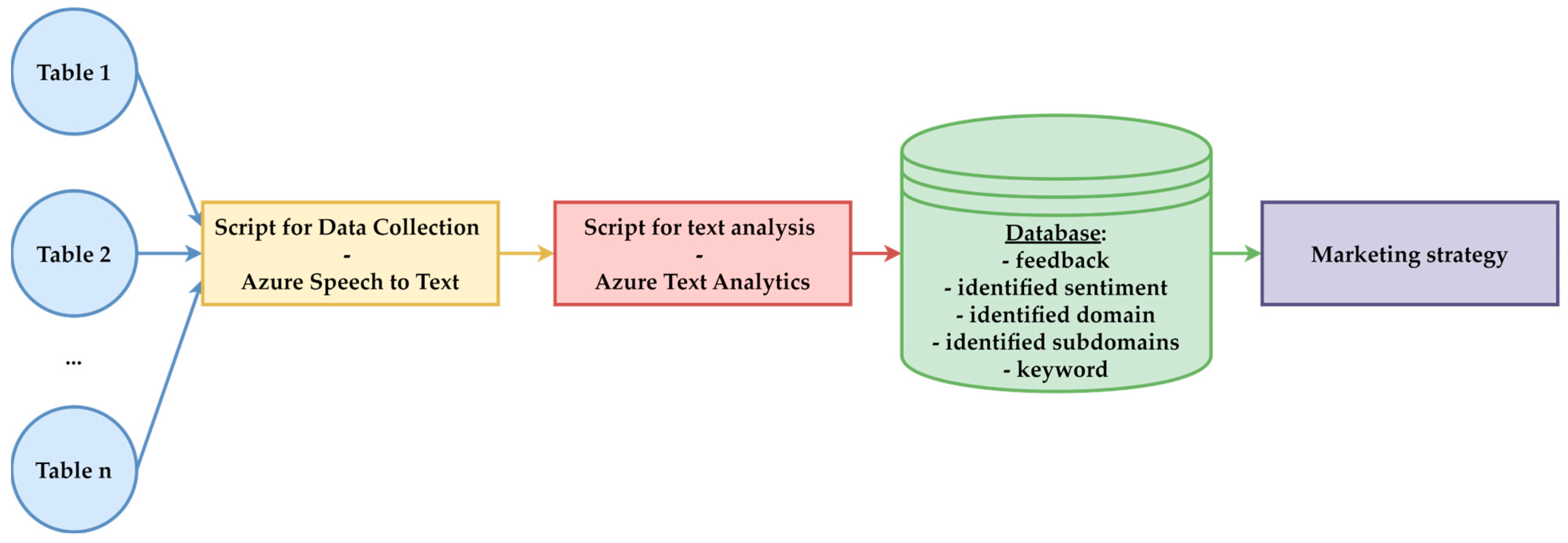
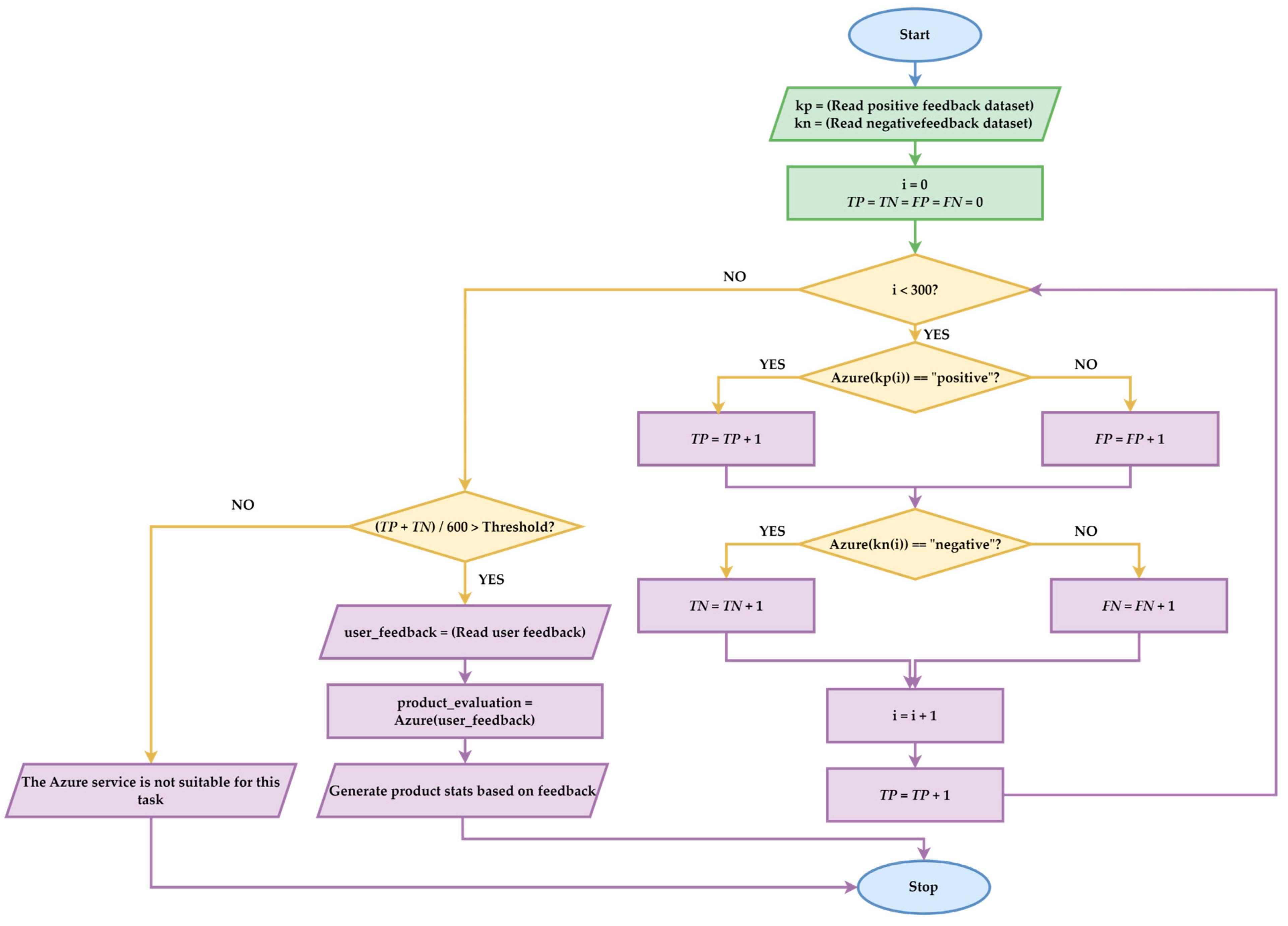
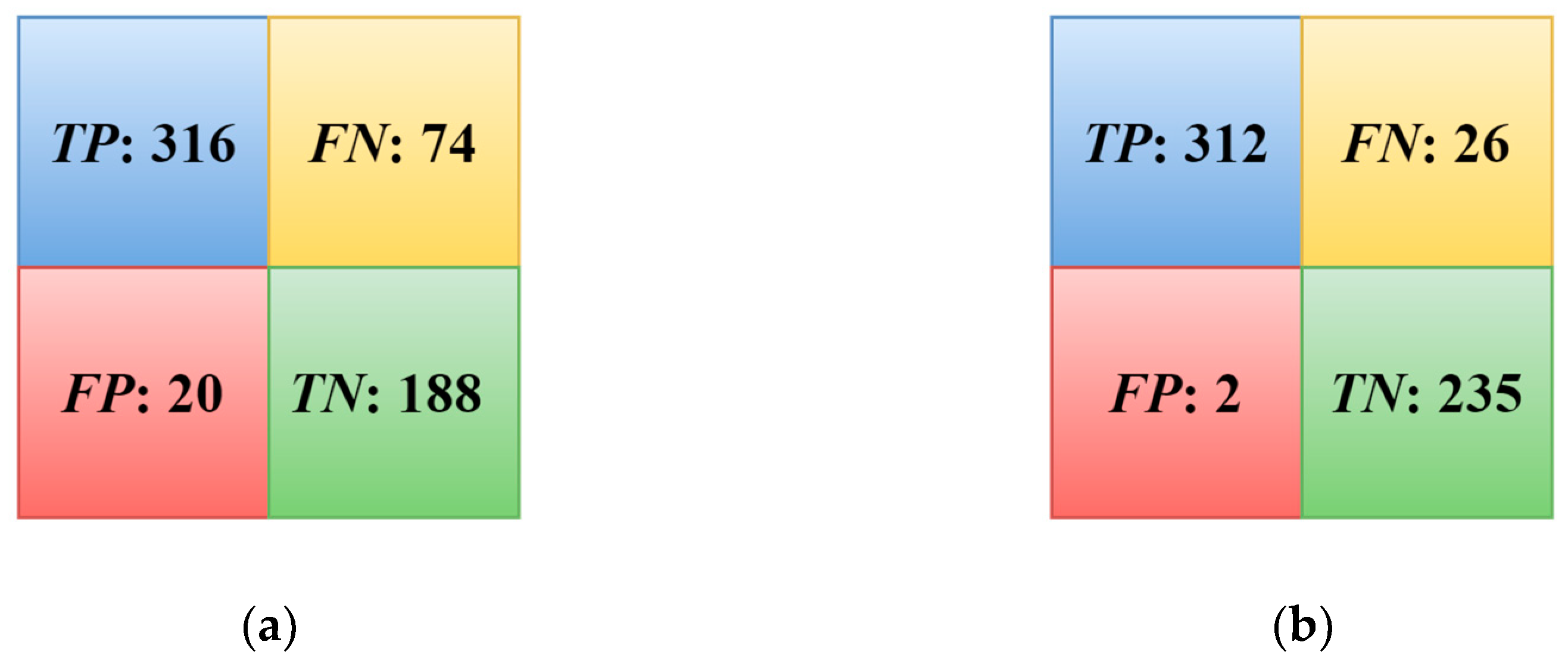



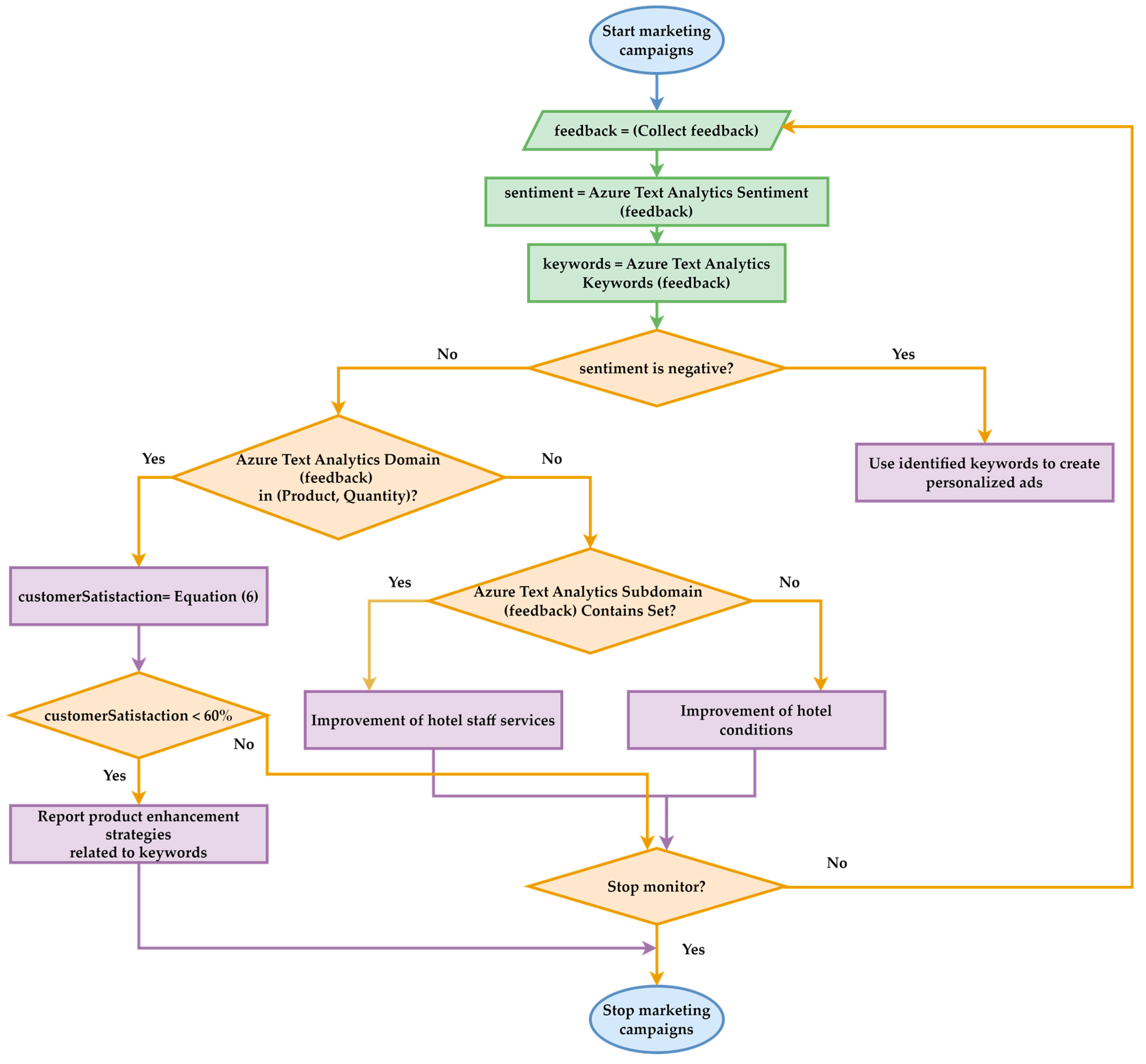
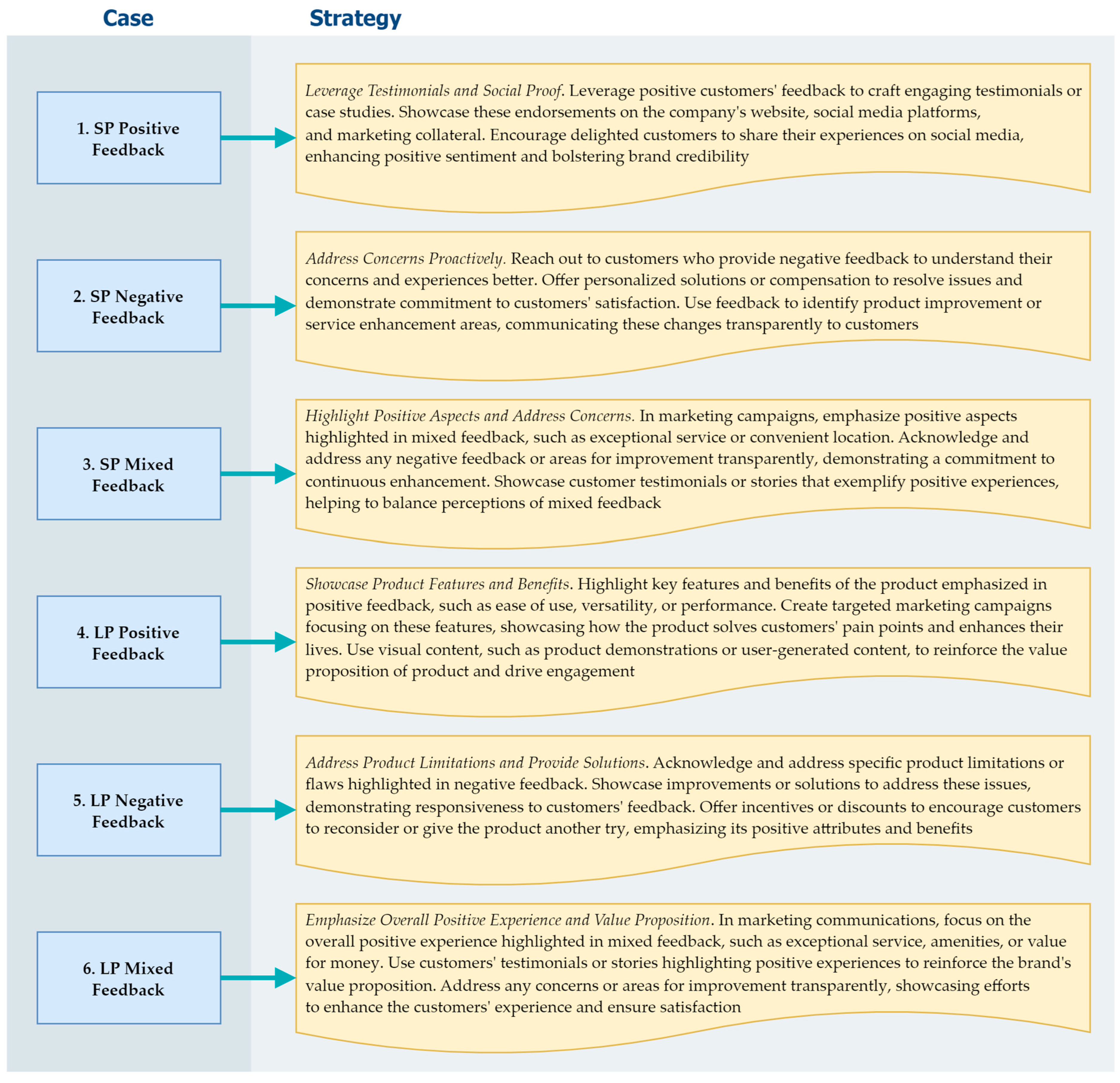
| Case | Example | Keywords |
|---|---|---|
| 1. SP Positive Feedback | The A Hotel provided us with a tranquil escape from the stresses of everyday life. The serene surroundings and attentive staff made for a truly relaxing stay | A Hotel, tranquil escape, everyday life, serene surroundings, attentive staff, relaxing stay, stresses |
| 2. SP Negative Feedback | The B product is all right but not particularly remarkable | B Product |
| 3. SP Mixed Feedback | Our experience at C Hotel was nothing short of exceptional. The cozy rooms, friendly staff, and convenient location made for a memorable stay | C Hotel, cozy rooms, friendly staff, convenient location, memorable stay, experience |
| 4. LP Positive Feedback | Since I upgraded to the D air fryer, cooking healthy and delicious meals has never been easier or more enjoyable! This versatile appliance uses hot air circulation to fry food with little to no oil, resulting in crispy and flavorful dishes with less fat and calories. I love how fast and efficient it is, with pre-programmed settings and adjustable temperature controls that ensure perfect results every time. The spacious basket allows for large batches of food, making it ideal for family meals or entertaining guests. Whether I’m making crispy French fries, juicy chicken wings, or tender vegetables, the D air fryer delivers restaurant-quality taste without guilt | D air fryer, hot air circulation, adjustable temperature controls, juicy chicken wings, crispy French fries, delicious meals, versatile appliance, flavorful dishes, less fat, programmed settings, perfect results, spacious basket, large batches, family meals, entertaining guests, tender vegetables, restaurant-quality taste, healthy, food, trim, oil, calories, guilt |
| 5. LP Negative Feedback | The E blender I purchased seemed promising initially, but it quickly revealed its flaws. Despite claiming to be powerful, it struggles with even the simplest blending tasks. The blades are dull, resulting in chunks of unprocessed ingredients. Cleaning is also a nightmare, with food particles trapped in hard-to-reach crevices. Overall, it was a disappointing purchase that failed to deliver on its promises | The E blender, simplest blending tasks, unprocessed ingredients, food particles, reach crevices, disappointing purchase, flaws, blades, chunks, cleaning, nightmare, promises |
| 6. LP Mixed Feedback | Our stay at F Hotel was nothing short of exceptional. We were greeted with warm smiles and impeccable service from the moment we arrived. The check-in process was seamless, and we were quickly escorted to our room, which exceeded our expectations. The room was spacious, elegantly furnished, and immaculately clean. The bed was incredibly comfortable, and we slept soundly each night of our stay. We also appreciated the attention to detail, from the luxurious bath amenities to the complimentary bottle of wine waiting for us upon arrival. The hotel’s amenities were equally impressive. We enjoyed relaxing by the pool, rejuvenating spa treatments, and savoring delicious meals at the on-site restaurant. The staff went above and beyond to ensure that every aspect of our stay was perfect, and we couldn’t have been happier with our experience. We highly recommend F Hotel to anyone looking for a luxurious and unforgettable getaway | Luxurious bath amenities, warm smiles, impeccable service, complimentary bottle, spa treatments, delicious meals, unforgettable getaway, F Hotel, stay, moment, process, room, expectations, bed, attention, detail, wine, arrival, pool, site, restaurant, staff, aspect, experience |
| SP Feedback | |||||||
| TP | TN | FP | FN | Accuracy | Precision | Recall | F1-Score |
| 52.84% | 31.44% | 3.35% | 12.37% | 84.28% | 94.04% | 81.02% | 87.05% |
| LP Feedback | |||||||
| TP | TN | FP | FN | Accuracy | Precision | Recall | F1-Score |
| 54.26% | 40.87% | 0.35% | 4.52% | 95.13% | 99.36% | 92.31% | 95.71% |
Disclaimer/Publisher’s Note: The statements, opinions and data contained in all publications are solely those of the individual author(s) and contributor(s) and not of MDPI and/or the editor(s). MDPI and/or the editor(s) disclaim responsibility for any injury to people or property resulting from any ideas, methods, instructions or products referred to in the content. |
© 2025 by the authors. Licensee MDPI, Basel, Switzerland. This article is an open access article distributed under the terms and conditions of the Creative Commons Attribution (CC BY) license (https://creativecommons.org/licenses/by/4.0/).
Share and Cite
Stancu, A.; Panait, M. Marketing Strategy Metamorphosis Under the Impact of Artificial Intelligence Services. Systems 2025, 13, 227. https://doi.org/10.3390/systems13040227
Stancu A, Panait M. Marketing Strategy Metamorphosis Under the Impact of Artificial Intelligence Services. Systems. 2025; 13(4):227. https://doi.org/10.3390/systems13040227
Chicago/Turabian StyleStancu, Adrian, and Mirela Panait. 2025. "Marketing Strategy Metamorphosis Under the Impact of Artificial Intelligence Services" Systems 13, no. 4: 227. https://doi.org/10.3390/systems13040227
APA StyleStancu, A., & Panait, M. (2025). Marketing Strategy Metamorphosis Under the Impact of Artificial Intelligence Services. Systems, 13(4), 227. https://doi.org/10.3390/systems13040227







